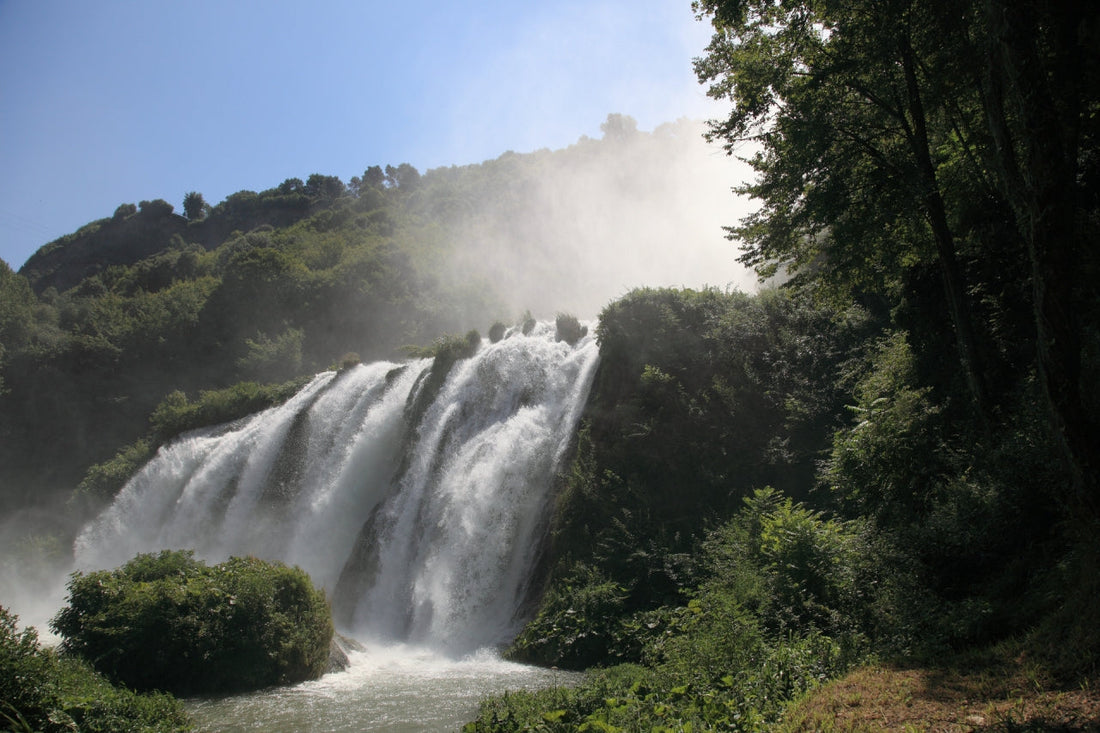
Marmore Falls in Umbria: where Nature meets History
Share
In the south of Umbria near Terni, nestled between the hills of Valnerina and the clear waters of the river Nera, are the Marmore Waterfalls (Cascate delle Marmore): one of the most spectacular and surprising places of the Green Heart of Italy.
At first glance they might look like a masterpiece of nature, but the truth is that they are man-made. This is also something that makes them truly unique, as they are also a work of human ingenuity, dating back more than two thousand years.
A masterpiece of Roman engineering

As we mentioned, the Marmore Falls were not born spontaneously. They were in fact built by the Romans in 271 BC, to solve a hydraulic problem that threatened the health and safety of the Reatina plain (surroundings of the city of Rieti). The Velino river, which flowed slowly in a swampy area, was at risk of becoming a source of disease. The solution? Build a canal - the Cavo Curiano, named after the Roman consul Manio Curio Dentato - that would channel the water to the underlying river Nera, and thus creating a spectacular artificial waterfall, which is still helping control the water flow of the 2 rivers nowadays.
Over the centuries, the waterfall was modified several times, especially during the Renaissance and in Napoleonic times, to improve its flow and reduce flooding downstream. The current appearance, with its 165 meters of difference in height distributed over three jumps, is the result of these interventions, which have combined functionality and beauty.
The waterfall today: an experience to live
Today the Marmore Falls are one of the most popular attractions in Umbria - and not only because of their height and scenic view. The site is perfectly organized to accommodate visitors of all ages, with hiking trails, panoramic viewpoints, and guided tours that tell history, legend and nature. In Particular, six paths have been created to ensure that everyone could enjoy the beauty of this site, with two of these paths being completely free.
One of the most fascinating aspects is that the waterfall is "controlled release": the water is opened at set times during the day, creating a unique scenic moment. Precisely during the times when water is open the view is most beautiful and suggestive. Feel the increasing roar of water, see it fall with force between the lush vegetation, surrounded by splashes and rainbows: it is a total sensory experience.
The main viewpoints are two: the Lower Belvedere, which allows you to admire the power of the waterfall from below (get ready to get wet!), and the Upper Belvedere, from where you can enjoy a breathtaking view on the highest jump and the surrounding landscape. Among the most suggestive trails there is the Path n.1, which connects the two points and includes the famous Tunnel of Lovers, which leads to a romantic balcony right next to the waterfall.

When to visit and practical tips
The Marmore Falls can be visited all year round, but spring and summer are the best seasons to fully enjoy the green landscape and mild climate. However, autumn gives breathtaking colors, and in winter, the water flow is often at its maximum strength, so at any time during the year you can enjoy a breathtaking view.
Admission is for a fee, but the ticket includes access to all trails and viewpoints. It is advisable to consult the water release times, available on the official website, to plan the visit at times when the waterfall is active.
Comfortable shoes, a raincoat (if you get too close), and maybe a camera: just a few elements are enough to turn a day into a real adventure.
How to get to Marmore Falls
The Marmore Falls are located in Umbria, near the town of Terni. They are nestled between green hills, however it is quite simple to reach them:
- By Car: If you are travelling from Rome, take the A1 motorway towards Florence and exit at Orte. From there, follow the Terni-Orte junction to the Terni Est exit, then follow the signs for the Marmore Falls. The journey takes about 1 hour and 30 minutes. If you land at the airport of Perugia, you can reach the Marmore Falls in about 1 hour and 20 minutes. The recommended route is to take the SS75 towards Foligno, then continue on the SS3 towards Spoleto and finally follow the signs for Terni and Cascata delle Marmore.
- By Train: From Roma Termini station, take a train to Terni. The journey takes about an hour. From Terni station, you can take a local bus (line 7 or E621) that will take you directly to the waterfalls. From the Perugia airport, use the Umbria Airlink service, which connects the airport to the railway stations of Perugia and Assisi. Once you reach the station of Perugia or Assisi, take a train to Terni. From Terni, use the Marmore Link service, a combined train + bus connection that will take you directly to the Marmore Falls. Tickets for Marmore Link can be purchased in a single solution on the website of Trenitalia, selecting "Cascata delle Marmore" as your destination.
Where to Sleep Near the Marmore Falls
Here are some accommodation options near Marmore Falls. These options offer a variety of experiences, from lake views to close proximity to the waterfalls, allowing you to choose the accommodation that best suits your needs.
- Rossella House on the Lake, Piediluco
Apartment with a breathtaking view literally over the Piediluco Lake, just few minutes from the Marmore Falls. -
Hotel Miralago, Piediluco
Located on the shores of Lake Piediluco, this hotel offers rooms with lake views and a restaurant serving typical Umbrian dishes. It is about 4 km from the waterfalls. - Borgo San Valentino, Arrone
Featuring an outdoor pool and restaurant, this hotel is located approximately 3 km from the waterfalls, offering a comfortable and relaxing stay. -
Marmore Charming House, Marmore
Just 70 metres from the waterfalls, this property offers modern rooms and a rooftop terrace -
Casa Argenti, Arrone
Set near the Nera River Park, 6 km from the waterfalls, it offers rustic apartments with a kitchenette and panoramic views.
A symbol of Umbria
The Marmore Falls are not only a must-see for tourists, but also represent a deep symbol of Umbria: a place where nature, history and human genius intertwine in harmony, really encapsulating everything Umbria is about. It is difficult not to be impressed by their grandeur, the purity of the waters, the games of light that are created between splashes and rainbows.
Visiting the Marmore is much more than seeing a waterfall: it is to feel the strength of a territory that, despite being ancient, never ceases to surprise. It is to immerse yourself in a landscape where every element - water, stone, green - tells a thousand-year history.
Che spettacolo, che Umbria!
